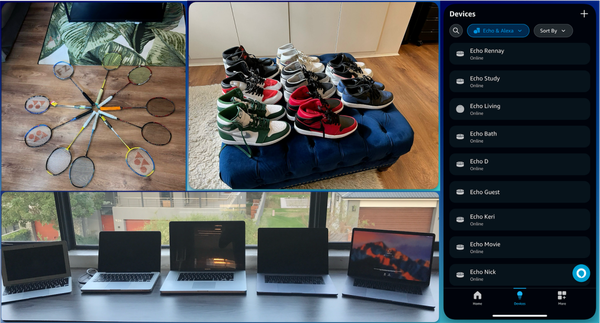Home Tech: My Power Plan
In this series of articles, I discuss technology solutions which I have successfully deployed at my home and which you can too.
Published 03-11-2021
The definition of insanity is doing the same thing and hoping for a different outcome. To be brutally honest, our hope that Eskom will end load shedding anytime soon has well crossed that line into insanity. I can clearly recall the first instance in 2008 as I worried that the clutch on my aging car would not survive the additional traffic. Fast-forward 13 years later, billions spent on new power stations, and we are still in the grip of "rolling blackouts".
Early in 2015, while huddled around a backup light, I came to the conclusion that we did not have to accept the situation and made a decision to work through it. In this post, I provide insight, practical details and solutions to what gets our family through load shedding.

Rank and file
The first step is to walk around your home and identify your the items you need during load shedding - and rank them in order of importance.
This is my list, in order of priority:
- Stove - with young kids, hot home-cooked meals was a non-negotiable. A quick win was a gas solution.
- Lighting - key areas: kitchen and living areas
- Internet & WiFi - you've probably noticed this is a tech blog. Enough said.
- Television - not a high priority, but not missing a live sporting event is priceless.
Items which did not make the list:
- Geyser - no major requirement for hot water as the water remained warm
- Airconditioning - it is remarkable how you can cool down a space by simply opening doors and windows and creating a cross ventilation flow
- Microwave - not at all important during load shedding
- Washing machine - not a core requirement
Phase 1: Build a buffer
After some investigation and research, I came up with the first iteration of our backup power solution. As you will note from the diagram below, it simply creates a buffer between the municipal power and the house. Same idea that allows scuba divers to stay underwater for longer.

The Inverter
The magic ingredient for an electrical backup solution is an inverter. Simply, and without getting into technical details, it is used to:
- convert and store municipal power into a battery
- convert and use battery power if there is no municipal power
After sourcing an inverter and batteries, I set up the solution illustrated below. A few notes:
- This is an "inline" solution. The inverter is smart enough to know when there is no municipal power and automatically switches over to battery.
After much research, I found that a "pure sine wave" inverter is much friendlier to electronics - such as televisions and computer equipment. It is a little more expensive - but safer in the long run.

With this solution, we had lighting in a few key areas, a WiFi-enabled internet connection and TV (including a DStv decoder). In all honesty, given four and a half-hours of load shedding at a time and the capacity of the batteries, I slowly switched off "non-essential" equipment (first the TV and decoder), then some lights - just to be on the safe side. It was pretty cool as this allowed our family to maintain some semblance of normality during load shedding.
This solution is referred to as "grid-tied" as you still need a connection to the electricity grid - as the municipal power charges the batteries (buffer).
Cons
It would be irresponsible of me not to tell you about some of the drawbacks of this phase:
- Due to the capacity of the inverter and as it was an "inline" solution, using the microwave during the spin cycle of the washing machine caused an overload.
- The batteries were not lithium ion - very limited lifespan (3-4 years) - especially as there was no effective "power management".
- I have little visibility into the load and available capacity (apart from the battery meter on the inverter display which was quite erratic).
Phase 2: Use an alternative source (daytime only)
An option you could consider is to use solar panels as an alternate source of power. Energy from the sun is converted into electrical energy using Photo Voltaic (PV) panels - which is routed into the inverter. Based on the number of panels installed and strength of the sun, there could be sufficient power coming in so municipal power is not needed. Again, the inverter is "smart enough" to figure out when to use municipal or solar power and the change is done seamlessly.

If you run the numbers, you may find that the cost of this solution could be recovered in 18-36 months as you will be saving on your municipal electricity bill. We are extremely fortunate that our South African climate allows at least 10-12 hours of good sunlight every day.
Note: This solution will only work during the day.
This solution is also "grid-tied" as you need power from the electricity grid at night - unless you're Amish and plan to go to bed at sunset and wake up at sunrise.
Phase 3: Power4Less
As you might have guessed, this phase is a combination of the above solutions. The key difference is - unlike my initial attempt of a "home-grown" solution, with products sourced using a friend's company account and an electrician who I had to guide through the process, we were extremely fortunate to have this installation done by the Power4Less team -

Key notes:
- Our electric geysers (we have 2 due to the distribution of rooms around the house) were major guzzlers of power. These were replaced by energy efficient heat pumps - which uses 25% of the power. More about this in a later post.
- Our inverter solutions were sized to meet our power requirements - my wife is continually trying to find the upper limit by using a number of kitchen appliances concurrently.
- The inverter can be configured (via software) for better management of the batteries - which results in more efficient use.
- Lithium ion batteries are more expensive for a reason - just one 4.5kw battery can see us through 3 hours of load shedding and they have far longer lifespans.
- The solution can be monitored remotely - via a Web and App interface. Knowledge is power (no pun intended). Having a view of your consumption, PV generated through solar and battery capacity is invaluable and allows the kids to keep the TV on during load shedding more often than not.
TL;DR (too long; didn't read)
A quick summary - if the above was too detailed:
- Identify the items you need during a rolling blackout
- Use alternatives if possible - for example: a gas stove
- There are a wide range of solutions - pick one which meets your requirements
- It is more affordable than you think - Power4Less offers a financed solution (which essentially pays for itself)
- **Most importantly: ** You can do something!
We have been extremely fortunate to have not experienced an outage due to load shedding for a number of years now - even with the recent Stage 4 schedule. This is by the Grace of the Almighty, a fantastic Power4Less team who are energy solution experts and most importantly, a simple decision to doing something differently to get a better outcome.
If you have any questions or require any further information, drop me a mail at rennay@rennay.dev



